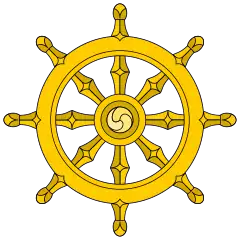Vasumitra (Buddhism)
Vasumitra was a Buddhist monk of the Sarvastivada school who flourished in the 2nd century CE. A native of Gandhāra, he presided over the 4th Buddhist council in Kashmir, administered by Kanishka I. He is credited as contributing to the Mahāvibhāṣā.[1]
| Translations of Vasumitra | |
|---|---|
| Sanskrit | Vasumitra |
| Chinese | 世友 or 婆須蜜多 |
| Japanese | 世友 (rōmaji: Seu) |
| Glossary of Buddhism | |
| Part of a series on |
| Buddhism |
|---|
 |
|
Contribution
Vasumitra put forward a thesis to defend the tenet of the Sarvastivada school that dharmas exist in the past and future as well as the present. According to this argument, dharmas exist in a noumenal or latent state in the future until they attain a moment of causal efficacy (karitra) in the present. This marks their entry into a functional relationship with other phenomena. When this moment is past, they reenter into a noumenal state that is understood as "past." Vasumitra's theory of temporality was accepted in preference to the views posited by other monks such as Dharmatrāta, Ghoṣa, and Buddhadeva.[2]
Ancestor
Vasumitra is the eighth zen ancestor. According to Soto Zen tradition, Vasumitra "always wore clean clothing. He used to wander around the villages carrying a wine vessel, whistling and singing. People thought he was crazy." [3]
References
- "Nichiren Buddhism Library". www.nichirenlibrary.org. Retrieved 29 December 2018.
- "Vasumitra". Oxford Dictionary of Buddhism. Oxford University Press. 2003.
- "Vasumitra". Transmission of light. Shambhala. 1990.